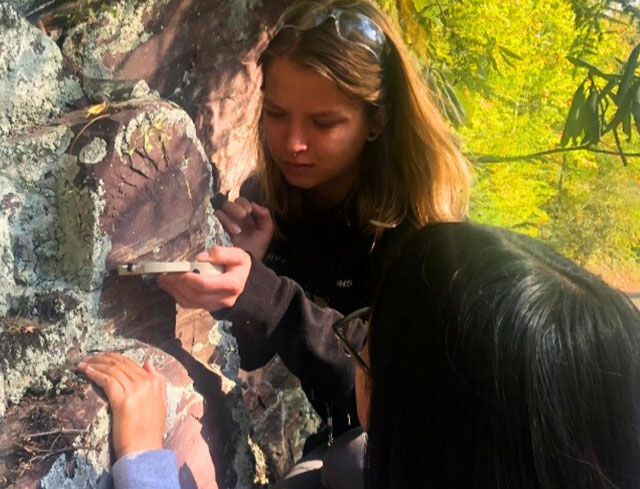Conserving Generosity
07 Feb 2022
The Blue Ridge Bartram Trail Conservancy and legacy of naturalist William Bartram
By: Kristin E. Landfield

In the colder months I often find myself in the woods. I need it more—I’m hungry for the oblique rays of winter’s soft sun. Naked trees frame silhouettes of stark ridgelines, making it possible to spot an eagle’s aerie on a skeleton Hemlock. Hibernal plants wait, protected from the wind by tawny leaf litter, though moss and partridgeberry still shine green on exposed rock. I find reassurance in the noisy crunch of leaves underfoot and sense a patient contentment. Like so many, I was lured to western North Carolina by its extravagant beauty: lavish vegetation, countless waterways, rugged geology and mile upon mile of hiking trails to explore. These trails are easy to take for granted. All over the region brown road signs lead us to an abundance of accessible paths. The yellow blaze of the Bartram Trail is one I’d passed several times before connecting the markings with the story of the gift underfoot. Being a plant enthusiast, I was familiar with William Bartram as an early American botanist. Bartram was responsible for identifying unique flora of the Southeast, collecting, drawing and even taxonomizing such species with the influential Swedish biologist Carl Linnaeus.
After making the connection between this ‘trailblazer’ and the path thousands of visitors walk annually, I became more interested in its lineage. The 110-mile commemorative trail starts at the Chattooga River, peaks in Georgia at Rabun Bald (4,696 feet), winds its way through the Nantahala National Forest in North Carolina to its apex at Wayah Bald (5,385 feet), finally terminating in Graham County, NC, at Cheoah Bald (5,062 feet). This trail closely approximates the path struck by William Bartram during his four-year expedition through the Southeast (1773-1777), during which he identified and recorded hundreds of species of flora and fauna, among these our beloved Oakleaf Hydrangea (H. quercifolia). In 1776, Bartram encountered the Cherokee people, of whom he wrote, “Their dispositions and manners are grave and steady; dignified and circumspect in their deportment… honest, just and liberal…they move with a becoming grace and dignity.” Many of his observations and renowned drawings were first published in 1791 as “Travels of William Bartram.” This book remains in circulation along with more recent publications further documenting his findings.
The Bartram Trail Society was informally organized in the early 1970s when they commenced to designate the trail as a protected national recreation area. The North Carolina Bartram Trail Society, now the Blue Ridge Bartram Trail Conservancy (BRBTC), formed in 1977. Through committed volunteers and private donations, the Conservancy has since developed and maintained approximately 135 miles of trails (primary and tributaries) and seeks to recover lost sections. Executive Director Brent Martin has embarked on an initiative to promote membership and increase volunteer and school programs, so honoring Bartram’s historical contribution and the trail’s diverse plant and wildlife communities. This means elevating awareness of the BRBTC’s work and increasing donations and grant funding. In 2021, with the help of such funding, the BRBTC contracted a Youth Conservation Corp for four weeks, repairing and improving many miles of trail. They hope to double this contract for 2022. Martin also plans to collaborate with allied agencies to connect the Bartram Trail to the Benton MacKaye and Foothills Trails.
In January, I was fortunate to participate in BRBTC’s volunteer day. A cheerful group improved a section from Osage Overlook (one of the most spectacular vistas on Highway 64) toward Hale Ridge. Clearing downed trees and limbs, cutting roots and repairing erosion, the group made keen progress on a portion of trail that is immediately accessed from a state highway. This work will silently benefit thousands of hikers in the coming year. It’s easy to assume these trails are borne of our tax dollars. They are not. In fact, this trail is almost entirely donation and volunteer fed. It was gratifying to participate and garner a shred of fulfilled responsibility alongside the dedicated group who has attended this trail for decades.
The early 20th-century philosopher Simone Weil recognized attention as the most radical act of generosity. Cognitively, she described such attention as an act of waiting, refraining from imposing one’s own schema, thus allowing the object to reveal itself. In practice, this radical sense of attention articulates itself in devoted acts. Perhaps attention is the chief calling of the naturalist—watchful awareness paired with faithful stewardship—a reciprocal gift to honor this land that feeds us. The Blue Ridge Bartram Trail Conservancy has shined nearly 50 years of generous attention on this extraordinary corridor. As the days lengthen, I’ll return to the West Fork, where I made mental note of a dormant patch of Iris versicolor. It’s one, among hundreds, of species connecting us with Bartram’s original journey. A volunteer suggested we leave some branches to protect the iris. This small yet caring act was a consequence of his generous attention. Many others will enjoy this healthy stand of iris, including swallowtail butterflies who will alight and pollinate its purple flowers. Bartram’s legacy will continue.
To join in the generous acts of the Blue Ridge Bartram Trail Conservancy, go to their website, replete with information on the trail, naturalist William Bartram, upcoming events and volunteer opportunities. www.blueridgebartram.org
For membership and donation, go to https://blueridgebartram.org/donate/
For 110 miles of adventure, look for a yellow blaze.













